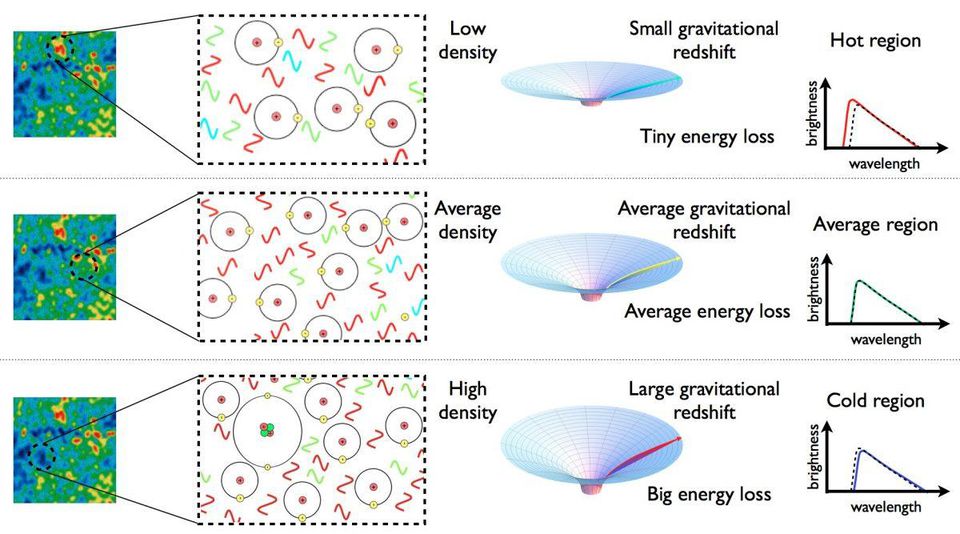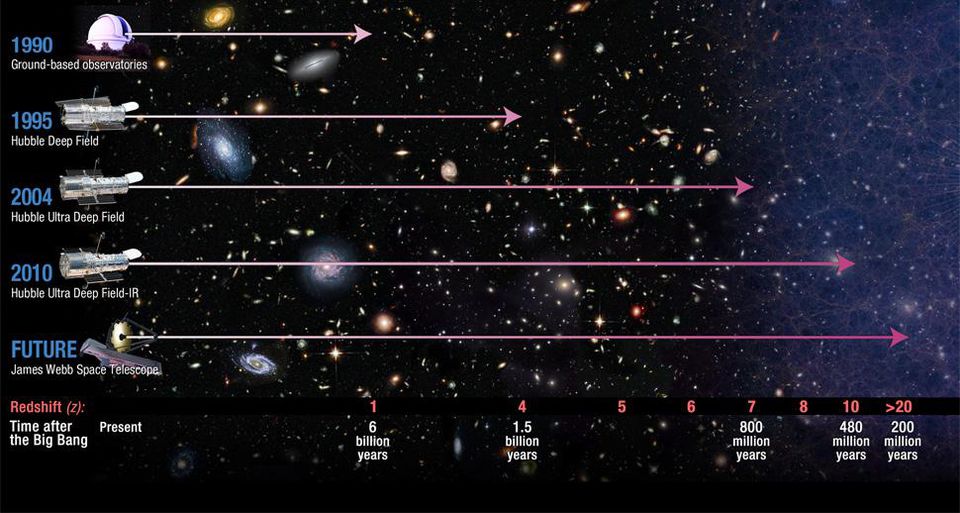At the time of the Big Bang, the Universe was filled with matter and radiation, but there were no stars in it. As they expanded and cooled, protons and neutrons were formed in the first split second, atomic nuclei in the first 3-4 minutes, neutral atoms in the first 380,000 years. After another 50-100 Ma, the first stars formed. But the universe remained dark, and observers, if such were, could not see anything until the moment that occurred about 550 million years after the Big Bang. Why did this happen? Our reader is interested in:
What I’m wondering is why the Dark Ages lasted hundreds of millions of years? It seemed to me that they should have lasted at least an order of magnitude less.
The formation of stars and galaxies is a huge step to create light, but this is not enough for the Dark Ages to end. And that's why.
 The early Universe was filled with matter and radiation, and was so hot and dense that it prevented stable protons and neutrons from appearing in the first fraction of a second. After their appearance and the annihilation of antimatter, we found ourselves with a sea of matter and radiation on our hands, darting back and forth with speeds close to light.
The early Universe was filled with matter and radiation, and was so hot and dense that it prevented stable protons and neutrons from appearing in the first fraction of a second. After their appearance and the annihilation of antimatter, we found ourselves with a sea of matter and radiation on our hands, darting back and forth with speeds close to light.Imagine the Universe as it was just a few minutes after its birth: before the formation of neutral atoms. The space is filled with protons, light nuclei, electrons, neutrinos and radiation. Three important things happen at this early stage:
- The universe is very homogeneous in relation to the amount of matter in any place, and the densest areas of all a few hundred-thousandth parts differ in density from the least dense.
- Gravity is actively tightening matter, and in denser regions there is an additional pulling force.
- Radiation, mostly in the form of photons, pushes matter away, resisting gravity.
As long as we have sufficiently energetic radiation, it prevents the formation of stable neutral atoms. Only when the expansion of the Universe cools the radiation strongly enough will neutral atoms cease to undergo immediate reionization.
 In the hot early Universe, before the formation of neutral atoms, photons are scattered from electrons (and, to a lesser extent, from protons) at a very high speed, transferring momentum in the process. After the formation of neutral atoms, the photons simply move in a straight line.
In the hot early Universe, before the formation of neutral atoms, photons are scattered from electrons (and, to a lesser extent, from protons) at a very high speed, transferring momentum in the process. After the formation of neutral atoms, the photons simply move in a straight line.After that, 380,000 years after the appearance of the Universe, this radiation (mostly photons) simply spreads freely in the same direction in which they went last, through the now neutral matter. 13.8 billion years later, we see this residual glow of the Big Bang as relic radiation. Today it is the background microwave radiation, since the wavelengths have been stretched due to the expansion of the Universe. More importantly, there is a distribution of fluctuations in the form of hot and cold spots corresponding to more and less dense parts of the Universe.
 The denser areas, the average density, and the less dense areas that existed when the Universe was 380,000 years old correspond to the cold, medium, and hot spots of the CMB.
The denser areas, the average density, and the less dense areas that existed when the Universe was 380,000 years old correspond to the cold, medium, and hot spots of the CMB.After the formation of neutral atoms, gravitational collapse becomes much easier to occur, since photons easily interact with free electrons, but poorly with neutral atoms. And as the photons are cooled to lower and lower energies, the importance of matter for the Universe increases, so the gravitational growth begins. It takes about 50-100 Ma for gravity to pull together quite a lot of matter, and for gas to cool enough to allow a collapse to begin when the first stars form. After that, nuclear fusion is launched, and the first heavy elements in the Universe appear.
 Large-scale structures of the universe appear over time; tiny defects grow and turn into the first stars and galaxies, then merge together to form the large, modern galaxies that we are seeing today. When we look at long distances, we see a younger Universe, similar to the past of our local area.
Large-scale structures of the universe appear over time; tiny defects grow and turn into the first stars and galaxies, then merge together to form the large, modern galaxies that we are seeing today. When we look at long distances, we see a younger Universe, similar to the past of our local area.But even with these stars, the Universe is in Dark Ages. Whose fault? Because of all these neutral atoms distributed throughout the universe. They are about 10
80 , and although for low-energy photons left after the Big Bang, this matter is transparent, for high-energy photons emitted by stars, it is opaque. That is why it is impossible to see the stars in the center of the Galaxy in visible light, but on longer waves (say, infrared) you can see directly through neutral gas and dust.
 Four different types of the Milky Way in four different wavelengths; at the top are long (submillimeter), then far infrared, near infrared and visible light. The foreground stars and dust tracks obscure the center of the galaxy in visible light from us.
Four different types of the Milky Way in four different wavelengths; at the top are long (submillimeter), then far infrared, near infrared and visible light. The foreground stars and dust tracks obscure the center of the galaxy in visible light from us.In order for the Universe to become transparent for starlight, these neutral atoms need to be ionized. They were already ionized once upon a time: before the Universe was 380,000 years old, therefore we call the process of their re-ionization
re -ionization. And only when enough stars are formed and enough high-energy ultraviolet photons will be emitted, this process of reionization can be completed and the Dark Ages can be put an end to. And although the very first stars could appear as early as 50-100 Ma after the Big Bang, our detailed observations show us that the reionization does not end until the Universe is 550 Ma.
 The diagram of the history of the universe, emphasizing the reionization, really occurred only after the formation of the first stars and galaxies. Prior to this, the universe was filled with neutral atoms blocking light. Although most of the universe has not undergone reionization until the time when it turned 550 million years old, some of the most fortunate parts have been reionized and earlier
The diagram of the history of the universe, emphasizing the reionization, really occurred only after the formation of the first stars and galaxies. Prior to this, the universe was filled with neutral atoms blocking light. Although most of the universe has not undergone reionization until the time when it turned 550 million years old, some of the most fortunate parts have been reionized and earlierHow did it happen that the earliest galaxies that we see appeared when the universe was only 400 million years old? And how can the James Webb telescope be able to look further into the past? Two factors play a role here:
1) Reionization is not homogeneous. The universe is full of lumps, imperfections and inhomogeneities. This is good, it allows stars, galaxies, planets, as well as humans to form. But it also means that some parts of space and direction in the sky were completely re-ionized before others. The most distant galaxy known to us,
GN-z11 , is a bright and beautiful galaxy for such a young age, but it is also located in the direction in which the Universe was almost completely ionized. It just so coincided that it happened 150 million years before the “average” reionization.
 Just because this distant galaxy GN-z11 is located in a region where the intergalactic medium is mostly reionized, Hubble could show it to us today. James Webb goes much further.
Just because this distant galaxy GN-z11 is located in a region where the intergalactic medium is mostly reionized, Hubble could show it to us today. James Webb goes much further.2) These neutral atoms are transparent for long wavelengths. Although in those early times the Universe was opaque to visible and ultraviolet light, for longer wavelengths it was transparent. For example, it is known that the "
Pillars of Creation " are opaque to visible light, but if you look at them in the infrared, you can easily see the stars inside them.
 On the left - a view in visible light, on the right - in the infrared, on the same object: Pillars of creation. Note how much gas and dust are more transparent to infrared radiation, and how this affects the background and internal stars.
On the left - a view in visible light, on the right - in the infrared, on the same object: Pillars of creation. Note how much gas and dust are more transparent to infrared radiation, and how this affects the background and internal stars.The James Webb telescope will not only become the main infrared observatory, but was designed specifically to observe the light that was infrared when it was emitted by the early stars. Stretching further, to wavelengths of 30 microns, in the middle of the infrared range, he will be able to observe objects that existed in the Dark Ages themselves.
 Studying the increasing expanses of the Universe, we get sensitivity not only to dimmer objects, but also to the fact that they are “blocked” by neutral atoms. But with infrared observatories we can see them too.
Studying the increasing expanses of the Universe, we get sensitivity not only to dimmer objects, but also to the fact that they are “blocked” by neutral atoms. But with infrared observatories we can see them too.The universe was dark for so long, because the atoms inside it were neutral for so long. Even the 98% reionized Universe remains opaque to visible light, and stellar light took about 500 Ma for complete ionization of all atoms and making the Universe transparent. At the end of the Dark Ages, we can see everything at all wavelengths of light, but before that we either have to get lucky or we need to look at longer, less absorbed waves.
Saying "let there be light," forming stars and galaxies, is not enough to end the Dark Ages of the Universe. Creating light is only half the battle; it is just as important to create an environment in which it can spread all the way down to your eyes. For this we need a lot of UV light and time. But if you look right, we can look into the darkness and see what we have not seen before. And in less than two years, this story will begin.
Ethan Siegel - astrophysicist, popularizer of science, blog Starts With A Bang! He wrote the books Beyond The Galaxy , and Treknologiya: Star Trek Science [ Treknology ].